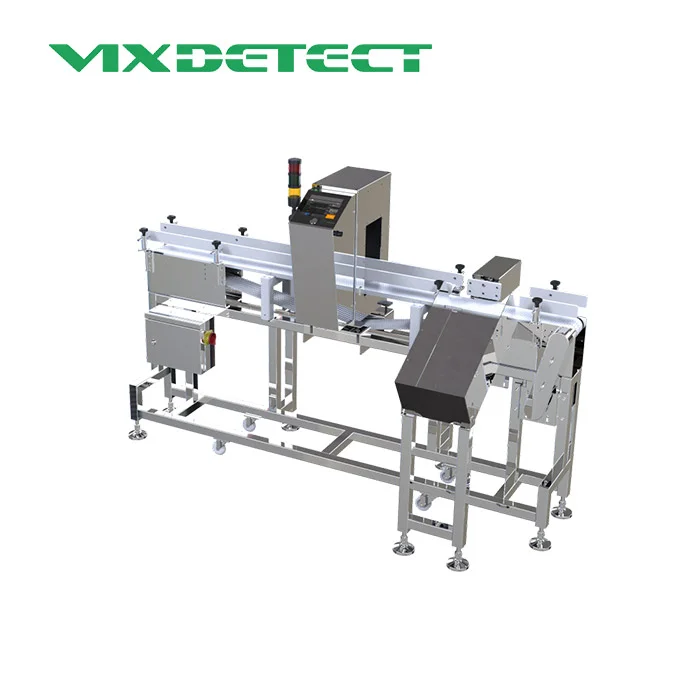- This topic is empty.
-
AuthorPosts
-
09/10/2025 at 14:55 #5941
In the modern food industry, food safety remains a core concern for consumers and businesses. This is particularly true in the snack food industry, where the diverse product range and complex processing procedures create a high risk of metal contamination, directly impacting food safety and a company's brand reputation. To effectively ensure food safety, food metal detectors, as key detection equipment, have become an indispensable tool for snack food processing companies. This article, drawing on real-world cases, will provide a detailed analysis of the application and value of food metal detectors in snack food processing.
1. Safety Challenges in the Snack Food Industry
Snack foods primarily include potato chips, nuts, biscuits, candy, and puffed foods. These foods may be contaminated by various metals, such as steel needles, iron filings, and aluminum flakes, during processing, packaging, and transportation. Key sources of risk include:
Raw Material Contamination: Nuts, grains, and other raw materials are susceptible to metal fragments during procurement, transportation, and storage.
Production Equipment Wear: Wear and tear of mechanical components in mixers, slicers, and baking equipment can introduce metal particles into food.
Packaging: Malfunctions in packaging machinery or conveyor belts can also introduce metal contamination. Human error: Small metal objects, such as screws and tool pieces, may be dropped by workers during handling.
If these risks are not effectively controlled, they could result in consumer injuries and even trigger large-scale product recalls, resulting in financial losses and damage to the company's brand reputation. Therefore, snack food processing companies must adopt efficient and accurate metal detection methods.

2. Working Principle and Advantages of Food Metal Detectors
Food metal detectors utilize electromagnetic induction technology to quickly detect metallic foreign objects in food. Their core principle is to induce currents in metal objects through an alternating magnetic field, generating signals that can be recognized by the detector. Key advantages include:
High sensitivity: Detects tiny metal fragments, ensuring food safety.
Non-contact detection: Avoids damage to product shape and packaging integrity.
Fast response: Suitable for high-speed production lines, ensuring both efficiency and safety.
Intelligent control: Some advanced equipment can automatically eliminate false alarms and support data recording and traceability.
Taking advantage of the characteristics of snack foods, metal detectors can adjust their sensitivity to accommodate varying densities and packaging materials, ensuring detection accuracy.
3. Application Case: Practical Experience at a Nut Processing Company
3.1 Company Background
A large nut processing company produces over 50 tons of snack foods, including roasted chestnuts, pistachios, and almonds. The company's main challenges are small metal fragments in the raw materials and micro-metal foreign matter caused by wear and tear on processing equipment.
3.2 Detection Solution
The company has installed food processing metal detection equipment at key stages of the production line. The specific solution is as follows:
Raw Material Conveying: Before the raw materials enter the cleaning and screening stages, high-sensitivity metal detectors are used to detect foreign matter in the raw nut materials. Metal fragments are automatically removed from the raw materials to ensure raw material safety.
Post-Roasting: Tiny metal particles generated by the equipment during the roasting process can enter the finished product. Medium-sensitivity metal detectors are installed in this stage to prevent metal foreign matter from entering the finished product.
Pre-Packaging: Before the products enter the packaging machine, a final metal detection is performed to ensure 100% safety of the packaged products. The equipment features an automatic rejection function to isolate metal-containing products and prevent them from entering the finished product.
3.3 Results and Experiences
Through the above solutions, the company achieved significant results:
Improved detection accuracy: Detecting tiny metal fragments in raw materials reduces potential risks.
Reduced recall rate: The final inspection before packaging effectively prevents product from entering the market.
Improved production efficiency: The automated rejection system reduces manual inspections and ensures smoother production line operation.
Data traceability: The equipment records inspection data, supporting quality management and safety traceability.
The company also discovered that adjusting metal detector sensitivity for different product types is crucial. For example, the high oil content of fried nuts affects detection sensitivity, requiring appropriate adjustment of detection parameters to ensure no missed detections.
4. Application Case: Practice of a Puffed Food Processing Company
Puffed foods, such as potato chips and corn cobs, are prone to debris during production. Furthermore, their light weight and low density place higher demands on metal detector sensitivity.
4.1 Company Background
A puffed food company produces approximately 30 tons of puffed food daily. The production line includes frying, seasoning, cooling, and packaging. The company hopes to minimize losses caused by false positives while ensuring product safety.
4.2 Detection Plan
Post-frying cooling section: Because high-temperature frying can easily cause mechanical wear, a high-sensitivity metal detector is installed to detect foreign objects in real time.
Post-seasoning conveying section: Seasoning powder may obscure metal signals, so the detector sensitivity is adjusted to a lower level to avoid false alarms.
Finished product packaging section: A final inspection is performed to ensure that the products leaving the factory are free of metal foreign objects. The equipment automatically rejects finished products containing foreign objects.
4.3 Results and Experiences
Reducing false alarm rates: By adjusting sensitivity and segmented detection, the false alarm rate has been significantly reduced.
Increasing consumer trust: Product safety is ensured and brand image is enhanced.
Optimizing production processes: Integrating metal detection into the production line avoids repeated inspections and improves efficiency.
Experience with puffed food companies shows that the appropriate multi-point detection setup and sensitivity adjustment are key to ensuring food safety.
5. Precautions for Using Metal Detectors
Regular equipment calibration: Maintain detection accuracy and prevent missed detections or false alarms.
Adapting to product characteristics: Adjust detection parameters based on food density, moisture content, and packaging material. Multi-point Inspection Layout: Inspection points must be established throughout the raw material, processing, and packaging stages to form a comprehensive defense system.
Record and Traceability: Regularly check equipment data and establish quality management records.
Personnel Training: Operators must be familiar with equipment functions and maintenance methods to enhance production safety.
6. Summary
Food metal detectors play a vital role in snack food processing. Through scientific and rational application and layout, they not only effectively prevent metallic foreign matter from entering products but also improve production efficiency, reduce recall risks, and enhance corporate brand credibility. Whether it's nuts and puffed foods, or candy and biscuits, metal detectors provide a solid guarantee for food safety.
For snack food companies, the introduction of advanced metal detection technology, combined with multi-point inspection, sensitivity adjustment, and data traceability, will become the standard for future food processing safety management. As technology continues to advance, food metal detectors will continue to play a greater role, providing consumers with safer, more reliable, and delicious snack foods.
http://www.vixdetect.net
vixdetect -
AuthorPosts
- You must be logged in to reply to this topic.


